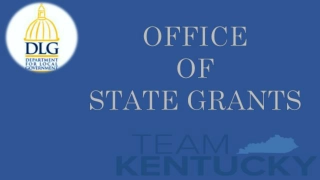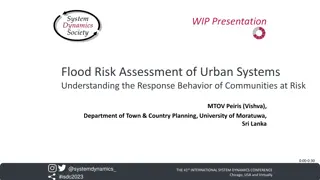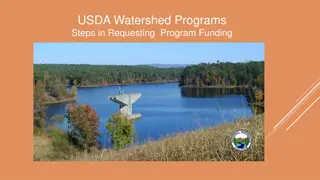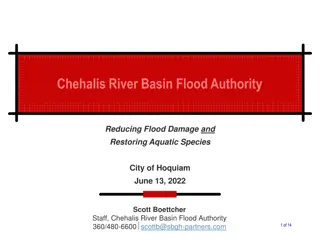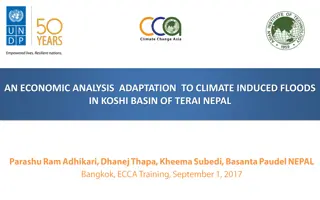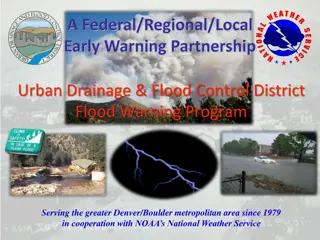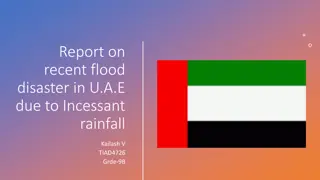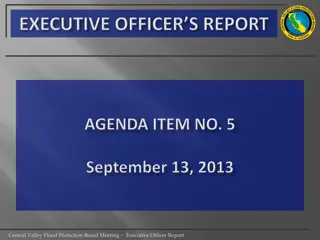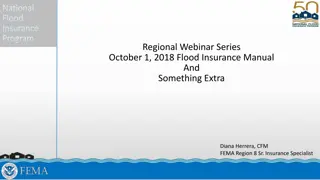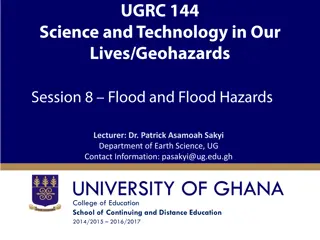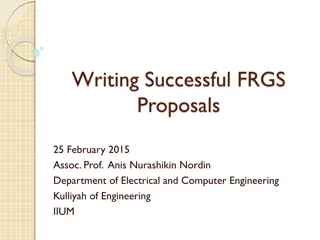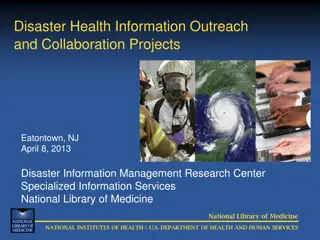Government's Immediate Response to Recent Flood Disaster: Overview and Assessment
Understanding the background and context of the recent flood disaster in KwaZulu-Natal (KZN) and other affected areas, this briefing outlines the government's quick response, including the declaration of a national state of disaster, coordination efforts, and actions taken by various government bodies. The Disaster Planning, Monitoring, and Evaluation (DPME) has been actively involved in planning, budgeting, monitoring, and integrating disaster response efforts within existing frameworks. The ongoing assessments highlight the severity of the disaster with significant fatalities, damages to homes, and other challenges faced by the affected communities.
Download Presentation

Please find below an Image/Link to download the presentation.
The content on the website is provided AS IS for your information and personal use only. It may not be sold, licensed, or shared on other websites without obtaining consent from the author. Download presentation by click this link. If you encounter any issues during the download, it is possible that the publisher has removed the file from their server.
E N D
Presentation Transcript
Planning, Monitoring and Evaluation: Initial overview of government s immediate response to the recent flood disaster Briefing by the Minister in the Presidency to the Ad- Hoc Committee on Flood Disaster Relief and Recovery 23 May 2022
Background in brief 1. Background and context 2. Analysis of causal factors 3. Coordination and institutional arrangements 4. DPME contribution towards disaster management efforts a. Planning and budgeting b. Monitoring c. Data systems support d. Ministerial visits and interventions 2
Background and Context From 8-13 April 2022, KZN experienced prolonged heavy rainfall, with between 200 and 400 millimeters in a space of 24 hours on 11 and 12 April 2022. This resulted in a flooding disaster in most areas around KZN and parts of the Eastern Cape. On 18 April 2022, the President addressed the nation on the matter; and the Minister of Cooperative Governance and Traditional Affairs (COGTA) issued a Gazette under Section 3 of the Disaster Management Act 57 of 2002 ( the Act ) declaring the National State of Disaster on the Impact of Severe Weather based on the National Disaster Management Centre (NDMC) recommendation. The declaration of a national disaster, in effect, confers the responsibility for coordination and management of the disaster to the national executive: o This enables the mobilization of resources from across the board. Various organs of state are required to support and strengthen existing structures to implement contingency arrangements and to ensure that immediate relief, recovery and reconstruction measures are put in place to effectively deal with the effects of the disaster. The different spheres of government have made specific pronouncements outlining their interventions. Other social partners have done the same. The DPME was requested to provide support in relation to integrated planning, monitoring and evaluation and to integrate the disaster response within the planning and monitoring frameworks. This is in support of the national executive and is intended to complement the existing efforts of various structures. 3
Background and context (2) Work to assess the extent of the impact of the disaster has been done. However, this work still continues and information gets updated as new evidence emerge. Assessments at 20 April showed the following: Kwazulu-Natal Northern Cape 10 districts affected (uMkhanyakude, uThukela, uMzinyathi, UMgungundlovu, Zululand, EThekwini, ILembe, Harry Gwala, King Cetshwayo, UGu Amajuba) Fatalities 443 Missing persons 54 Injured persons 43 Homes totally destroyed 6568 Homes partially destroyed 10710 1 district affected (ZFM DM in the area of Tsantsabane Local municipality) No fatalities or missing persons attributed to the floods disaster Homes totally destroyed 20 houses +80 shanties Homes partially destroyed 23 North West Eastern Cape Districts affected 1 district affected, namely Ngaka Modiri Molema DM No fatalities and missing persons Injured persons 3 Homes totally destroyed 45 Homes partially destroyed 224 5 districts (Alfred Nzo, Amathole, Chris Hani, Joe Gqabi and OR Tambo) Fatalities 2 No missing persons Injured persons 3 Homeless 3768 Homes totally destroyed 2306 Homes partially destroyed 1857 Over above humanitarian needs are damages to business property (still to be quantified); Fuel shortages; Supply value chain disruption; Psychosocial challenges; and a broader challenges of public trust in government: susceptibility to corruption given past experiences. 4
Analysis of causal factors Development and settlement location outside the prescripts of SPLUMA in rural/ traditional authority areas Rapid urban development without climate change risk mitigation design protocols, controls and compliance Poor or no compliance with SPLUMA and regulations Poor maintenance of infrastructure including roads, bridges, stormwater, sewers, dams and retaining structures Poor construction of infrastructure including corruption during construction and maintenance Poor planning and design for climate change risks, adaptation and mitigation Location of informal settlements and buildings within flood prone areas such as flood lines, flood plains and riverbanks Slow pace of delivery within upgrading of informal settlements programme 5
Coordination and institutional arrangements Under the stewardship of the Minister of COGTA, relevant structures have been activated in terms of section 24(4) - (8) of the Act to provide an appropriate coordination mechanism for the overall nation response. Intergovernmental Committee on Disaster Management (ICDM) (Chair - Minister of COGTA): DMA-Sec 4 (1) (3) Members: Cabinet Members, MEC s of each Province, Members of municipal councils National Disaster Management Advisory Forum (NDMAF): DMA-Sec 5 (1)-(4) (Chair Head of NDMC) Members: senior reps of national depts, senior reps of prov depts, SALGA reps, DM Experts, National Joint Flood Coordination Committee (NJFCC) 5. 7. 3. 6. 1. 2. Humanitarian Relief (Lead: Social Development) 4. Communication & Community mobilization (GCIS) Security and Emergency Search and Rescue (SAPS) Integrated Flood Risk & Early Warnings (DCOG-NDMC) Infrastructure interventions: DPWI-MISA Health and Medical Services Food & Nutrition Security (DALRRD) (Lead: Health) 6
Government disaster response and recovery approach The President announce the three-phased approach to the overall government response and recovery, under which all interventions are to be coordinated: Immediate humanitarian relief Stabilisation and recovery Rehabilitation and reconstruction Ensuring that ll affected persons are safe and that their basic needs are met Rehousing people who have lost homes and restoring provision of services Focusing on building back better 7
Key interventions (1) Immediate intervention Search and rescue/ recovery Water and sanitation Restoration of water to communities and key facilities incl. bulk water, distribution network, pump stations, water tankers Roads and bridges Urgent repairs, removal of debris to restore road network Infrastructure projects Other public infrastructure Assessment of damage and processes to repair public infrastructure Human Settlement Temporary and more permanent shelter/ relocation Replacement of destroyed houses Financial assistance to households to repair damaged houses Identification of state land for resettlement 8
Key interventions (2) Social development Food parcels Temporary shelter, blankets, clothing and other basic needs including sanitary towels etc. Burial support incl. SASSA funding Psycho-social support and post-traumatic distress Education Functionality of schools affected)/ provision of mobile classrooms/ cleaning/ repairs Health Public health awareness on water-borne diseases Temporary or mobile clinics/ access to chronic medications Post-mortems Home Affairs Assistance with death certificates and other needs Mobile services to improve access to services 9
Key interventions (3) Finance Announcement of R1bn emergency funding Solidarity Fund reactivated for relief efforts and humanitarian assistance and to channel donor funding Business incl. SMMEs Support for small businesses incl. township and village enterprises, informal traders etc. affected by the floods Tourism cleaning beaches; water in hotels Telecommunications Restoration of telecoms network Safety and security Swift response to maintain law and order, including response to looting Deployment of 10000 SANDF members Most interventions cut across different phases and timeframes: immediate (emergency phase) Short-term (recovery and rebuilding) Medium and long-term 10
Contribution of the Department of DPME to the flood disaster management efforts 11
DPME role The DPME draws from its mandate to provide the required support to the overall national effort. Mandate of the DPME includes: Evaluation Interventions Planning Monitoring Development and implementation of national planning system and instruments; institutionalisation and coordination of integrated government planning Monitoring the implementation of government priorities, sector plans and capacity of the state institutions to implement programmes Evaluation of critical government programmes for their efficacy and value for money, among other criteria. Facilitate interventions to maximize developmental impact. Provision of relevant support and guidance in relation to PM&E Independently undertake PM&E activities Support executive oversight DPME role 12
The DPME role is various coordination structures The DPME is represented in various coordination and institutional structures in order to effective render its contribution: 1. At Ministerial level is the Intergovernmental Committee on Disaster Management (ICDM) 2. At DG level is the National Joint Flood Coordination Committee (NJFCC), which includes the Eight Technical Task Teams that support the national efforts. 3. Oversight Committee on the National State of Disaster on the Impact of the Severe Weather Events (OCNSD). The OCNSD was established in order to ensure public confidence and trust by making that, among others, there is transparency and accountability that the resources made available for the disaster intervention are utilised for the intended purpose and managed appropriately in terms of both value for money and impact on citizens. 13
Planning, budgeting and funding The national state of disaster may necessitate the revision of Strategic Plans and Annual Performance Plans of provincial departments in the KwaZulu-Natal province, as well as relevant national departments and other institutions with a mandate to intervene. Provide support in ensuring the development of a coherent and integrated plan The Revised Framework on Strategic Plans and Annual Performance Plans (2019) Chapter 3 (section 3.3.4) and Chapter 4 (section 4.4.4) provides guidance on the conditions under which Strategic Plans and Annual Performance Plans may be revised and re-tabled. The KwaZulu-Natal Office of the Premier will be advised to engage with the provincial legislature to agree on a feasible date to coordinate the re-tabling of the institutional plans in line with intervention plans and budget reprioritization processes. Ensure the integration of plans within the existing government planning system (national and provincial) and facilitate the necessary adjustments where required The revised institutional plans must reflect planned interventions in response to the national state of disaster and these interventions will be monitored through the quarterly reporting (QPR) process. The implementation of revised and re-tabled plans is subject to auditing by the Auditor-General of South Africa (AGSA). The impact of the disaster and its mitigation will also need to be taken into account in the development of the 2023-24 Budget Prioritisation Framework, the 2023-24 National Annual Strategic Plan and the medium-term framework for the 2024-2029 government term of office. DPME and NT engagements agreed on need for alignment on planning and budgeting. NT will be issuing a circular to guide departments on budget reprioritization and DPME will issue a circular on revision of APPs and SPs. 15
Planning and budgeting The funding framework for disaster is well defined and is governed by the following: Public Finance Management Act (PFMA) Division of Revenue Act (DORA) In general section 30 of PFMA allows for national adjustments and section 31 allows for provincial adjustments e.g. adjustments budget process Section 16 allows for the use of funds in emergency situations but this cannot exceed 2% of the total appropriated funds Section 43 allows for shifting of funds within a vote but may not exceed 8% of amount appropriated DoRA makes provision for provincial and municipal disaster response grants Transferring officer must determine the conditions for spending after consultation with NDMC and approval by National Treasury Given the legislative frameworks, departments can therefore fund immediate relief measures using section 43 of the PFMA It has also been indicated that NT has made R1 billion available but it is uncertain if this exceeds the limits provided Existing disaster response grants can also be utilised once a disaster is declared (in consultation with NDMC and NT approval) Significant additional funding will have to go through an adjustments budget process (section 30) It is thus advised that APP only be revised once project plans and funding mechanisms are confirmed Departments can indicate if they have undertaken internal reprioritisation of funding
Planning and budgeting The Department of Planning, Monitoring and Evaluation (DPME) must: Provide direction on the processes and conditions for the revision and re-tabling of the 2022/23 Annual Performance Plans (APPs) and the 2020-2025 Strategic Plans (SPs), Where applicable, take into consideration interventions in response to the flood disaster and the impact of the adjustment budget; if applicable, on the outcomes, outputs and targets reflected in the institutional plans. DPME held consultations with OTPs in KZN, EC and NW together with NT to discuss the approach to the revision of APPs. DPME subsequently issued Circular 5/2022 to provide guidance to national institutions and provincial institutions in KwaZulu-Natal, Eastern Cape, North West on the revision and re-tabling of the 2022/23 Annual Performance Plans (APPs) and the 2020-2025 Strategic Plans (SPs), where applicable, to incorporate the implementation of the response to the National State of Disaster to address the impact of severe weather events in the country. The purpose of revising and re-tabling plans is to incorporate the interventions and adjusted 2022/23 budget allocations; if applicable, in response to the impact of the flood disaster. The interventions would be linked to the three main overlapping phases of the disaster response as announced by President Cyril Ramaphosa, which are, humanitarian relief; stabilisation and recovery; and reconstruction and rebuilding. 17
Key planning issues Key DPME roles on planning: Provide support in ensuring the development of a coherent and integrated disaster response plan across the three identified phases using a results-based planning methodology Ensure the integration of disaster response plans within the existing government planning system (national and provincial) and facilitate the necessary adjustments where required. Key interventions include: Support for NDMC on integrated planning approach across the three phases Planning template for immediate and short-term interventions Planning template for phases two and three Consultation with affected provinces (KZN, EC and NW) Issuing of Circular 5 on the revision and retabling of 2022/23 APPs Support for affected departments and provinces on planning matters (provincial plans and institutional plans) Integration of disaster response within the 2023/24 planning and budgeting cycle, including Budget Prioritisation Framework, including addressing causal factors in medium and long-term planning.
Key planning issues Current planning challenges: Departmental plans do not include targets, indicators and timeframes. Interdependencies between departments are managed on an ad hoc basis. Key interventions include: DPME developed a planning template and will be working with departments to populate. DG s of DPME and Human Settlements in KZN to finalise the plans. DPME to explore the possibilities of MOU s between departments to manage interdependencies.
Planning: Revision and Re-tabling of 2022/23 APPs The Revised Framework on Strategic Plans and Annual Performance Plans (2019) Chapter 3 (section 3.3.4) and Chapter 4 (section 4.4.4) provides guidance on the conditions under which Strategic Plans and Annual Performance Plans may be revised and re-tabled. The Revised Framework for Strategic Plans and Annual Performance Plans (2019) is applicable to national and provincial departments, government components, Schedule 3A and 3C public entities and constitutional institutions. National institutions and provincial institutions in KwaZulu-Natal, Eastern Cape and the North West provinces must revise and re-table their 2022/23 Annual Performance Plans and 2020- 25 Strategic Plans, where applicable, by 30 June 2022 for implementation from 01 July 2022. The factors below must be considered to inform the revisions of the 2022/23 Annual Performance Plans (APPs) and the 2020-2025 Strategic Plans (SPs), where applicable: 20
Planning: Revision and Re-tabling of 2022/23 APPs Processes to be followed when revising a Strategic Plan: Institutions must reflect the revisions to the Strategic Plan through the re-tabling of the whole Strategic Plan or the tabling of an Annexure to the Annual Performance Plan. If the changes in policy, service delivery environment and planning methodology result in the revision of the vision, mission, values and impact statement, outcomes, outcome indicators or targets, institutions must comprehensively revise the Strategic Plan which must be re-tabled in the relevant legislature. If the changes are minimal, institutions must reflect such revisions to the Strategic Plan as an Annexure to the Annual Performance Plan, which must be tabled in the relevant legislature. Processes to be followed when revising an Annual Performance Plan: Revision of the outcomes in the Strategic Plan may require the revision of the outcomes and outputs in the Annual Performance Plan to ensure alignment. Targets changed as a result of the in-year budget adjustment process must be reflected in a re- tabled Annual Performance Plan and Adjusted Estimates of National Expenditure (ENE) or Adjusted Estimates of Provincial Revenue and Expenditure (EPRE). 21
Planning: Revision and Re-tabling of 2022/23 APPs In an event that the institution is revising the annual targets and subsequently the quarterly targets in the Annual Performance Plan, the institution is advised to reflect the revisions as follows: The revised annual targets must include the quarterly targets reflected in the originally tabled APP that have been implemented up to the date of the re-tabling. In addition, the revised annual targets must include the adjusted quarterly targets for the remaining quarters of the financial year. Revised plans must be re-tabled in Parliament or the relevant Provincial Legislature. A revised Annual Performance Plan that is implemented without being re-tabled in Parliament or a Provincial Legislature will not be considered an official, revised Annual Performance Plan. The revised and re-tabled plans, together with proof of re-tabling, must be submitted to the Department of Planning, Monitoring and Evaluation (DPME) within two weeks after re- tabling. The DPME will guide the respective institutions on capturing the re-tabled APP in the Electronic Quarterly Performance Reporting System (eQPRS). 22
Planning: Revision and Re-tabling of 2022/23 APPs The revised and re-tabled 2022/23 Annual Performance Plans (APPs) and the 2020-2025 Strategic Plans (SPs), where applicable, must be published on the institution s website within two weeks after re-tabling. Further, the re-tabled 2022/23 Annual Performance Plans (APPs) and the 2020-2025 Strategic Plans (SPs), where applicable, must be shared with the stakeholders including the legislature, the Department of Planning, Monitoring and Evaluation, the Offices of the Premier (where applicable) and relevant Treasuries. The implementation of revised and re-tabled plans is subject to auditing by the Auditor- General of South Africa (AGSA) and oversight by relevant government institutions. The DPME, in collaboration with the National Treasury, will continue to provide guidance on the completion of Annual Reports against the Annual Performance Plans. 23
Budget Prioritisation Framework 2023 Government s disaster response has three phases: Phase 1: Immediate humanitarian relief Phase 2: Stabilisation and recovery Phase 3: Rehabilitation and reconstruction Immediate relief is funded through reprioritisation of existing funding and through the disaster response grants based on National Treasury approvals However phases that support stabilisation, recovery and reconstruction will continue into the next financial year The draft Budget Prioritisation Framework (BPF) 2023 supports the strategy of stabilisation and recovery Key medium term priorities should include the following: Repair and rebuilding of public infrastructure (including schools, health facilities and housing) Restoration of economic infrastructure (incl. port, bridges, roads and rail networks) Support businesses (especially SMMEs, agriculture, retail and manufacturing) Optimisation of social support and public employment programmes Building resilience to future disasters Departments will be requested to prioritise these interventions as part of their budget submissions for the upcoming budget process 24
Monitoring and evaluation system Provide support in developing and implementing a monitoring mechanism to track implementation of interventions, results and reporting in a manner that facilitates timely corrective measures, ensures accountability, promotes transparency and enhances public trust. Monitor that relevant structures and institutions are delivering on their appointed roles and initiate interventions to address shortcomings State Capabilities Capacity support to government (including OTPs) for data systems, data collection, integration, analysis and planning Conduct frontline monitoring visits to assess experiences of communities in terms of receiving the required support and tracking of results. Evaluate the efficacy of the intervention and ensure proper knowledge management. Mobilise relevant research and knowledge institutions to provide required research and analysis. Application of the Results Chain to unpack the interventions Inputs Activities Outputs Outcomes Impact What is delivered through implementation of interventions, e.g. services received by citizens/ beneficiaries Financial, human and other resources mobilized to support the intervention Results achieved following the use of the interventions/ service/ products Improvement/ changes realised at a societal or economy level Actions taken to implement the interventions 26
Applying the Results Chain to unpack the interventions Inputs Activities Outputs Outcomes/ Results - Government funding sources Capacity support (personnel and material) from national departments, other provinces and public institutions Development Finance Institutions Non-government sector funding and in-kind contribution International sector funding and in-kind contribution Phase 1: Provision of immediate humanitarian relief: - Public communication and information dissemination - Delivery of the humanitarian relief (Search and rescue/ recovery, burial assistance, death certificates, post-mortems, health services, psychosocial support, temporary shelter, food, personal essentials and emergency water supply, etc.) - Recoveries of the diseased and unaccounted/missing persons Uptake of humanitarian support (burial assistance, death certificates, post-mortems, health service, psychosocial support, temporary shelter, food, personal essentials and emergency water supply, etc.) - - Greater human security Enhanced citizen trust/confidence in authorities Mitigation of water borne diseases (cholera, diarrhoea, malaria, etc.) - - - - Phase 2: Stabilisation and recovery interventions: - Short term measures to repair, scrapping, buying/building anew of public infrastructure and facilities on the following: water and sanitation, stormwater and drainage infrastructure, electricity, roads and bridges, rail networks, telecommunication networks, health facilities, solid waste infrastructure, school infrastructure, human settlement and housing. - Provision of housing support - Provision of social relief of distress (SRD) grants - Restoration of essential/basic services and public infrastructure (water, electricity, schools, etc.) Restoration of telecommunication networks Uptake/ utilisation of vouchers for repair of houses and other housing support Uptake of social relief of distress (SRD) grants Uptake/ utilisation of assistance for repair of businesses - Public access to essential/basic services (i.e. water, electricity, key routes, schooling or learning infrastructure, telecoms networks, etc.) Business impact/recovery status Social protests/social sentiment status - - - - - - - - Phase 3: Reconstruction and building interventions: - Medium to long term interventions for economic recovery - Repair and restoration of economic infrastructure (SANRAL, PRASA, BAYHEAD, etc.) - Support to businesses (farms, warehouses, retail, etc.) - Provision of land for human re-settlement - Land use planning, urban and regional planning. - Rebuilding and repair of major public infrastructure Establishment of new public infrastructure Community resettlement and relocation processes Flood risks resilience strategies - Restored economic & industrial activities Sustainable environmental and natural resource management - - - - 27
Update on development of integrated data systems The DG level engagement with KZN province and the Department of Science and Innovation (20 22 April) established that the KZN provincial government needed support in integrating various streams of data in order to produce regular progress reports on key indicators. The CISR has been brought on-boarded from 21 April 2022 to build an information system to integrate various data platforms that were already in place. An information systems has now been established. Processes are in place to have this system provide regular reports to support strategic oversight and decision making by the established coordinating structures at various levels, local to national. Reports and data analysis produced in this information system will also support communications, citizen information and enhance transparency. A key recommendation is that the same information system must be replicated for the Eastern Cape and the North West. Highlights of progress to date. 28
M&E systems: Frontline monitoring, citizen feedback and research Scoping for frontline and citizen monitoring and research work has begun, looking at the following areas: (Considering a district based approach) Spot checks on temporary shelters including functionality. Monitoring of relief package (food parcel distribution), vouchers etc. Validation visits on restoration, reopening of public facilities, etc. Citizen feedback via focus groups assessing appropriateness, effectiveness, efficiency and timeliness of government response in the three phases. Monitor that relevant structures and institutions are delivering on their appointed roles and initiate interventions to address shortcomings: DPME and NSG with the support of the UNDP explore alternatives in disaster co-ordination structures and mechanisms. The approach Identify Analyse Intervene Identify areas of poor performance Where are the blockages? Institutional and structures failures Establish the reasons behind poor performance Mobilise support Coordinate implementation of support/intervention measures 29
Ministers KZN visit on 5 May 2022 The Minister in the Presidency, Hon Mondli Gungubele conducted a monitoring and evaluation (M&E) implementation visit to the Kwazulu-Natal Province on 05 May 2022. following the damage caused by the April 2022 floods. The Minister was received by the KwaZulu-Natal MEC for Economic Development Tourism and Environmental Affairs, Mr Ravi Pillay, Member of the Mayoral Committee (MMC) for Governance and Human Resources in eThekwini Metropolitan Municipality, Mr Nkosenhle Madlala. The visit included: Briefing session with various government departments, Briefing by entities and stakeholders such as the Durban Chamber of Commerce and Industry Site visits to the Port of Durban and Prince Mshiyeni Memorial Hospital, Umlazi V Section Community Hall / Shelter and Embizweni High School. Reports on the Minister s visit have been prepared and the key observations were shared with relevant structures to facilitate necessary interventions. 30
Outcomes of the Ministers KZN visit on 5 May 2022 Challenges identified during the visit Follow-up on the interventions activated Water supply challenges at Prince Mshiyeni Memorial Hospital (PMMH) The CEO of PMMH reported that from Monday 09 May 2022 that water supply has been restored and a week later confirmed that water supply is stabilized and sustained. The challenges identified at the Depot were still unresolved by 20th May upon follow- up. The province is appealing for a national level intervention on the challenges identified during the visit. Interruption of operations at KZN Provincial Pharmaceutical Supply Depot, flooding, electricity disruption and damaged files, etc. Operational and recovery challenges at various social facilities Challenges identified in the social sector facilities have been discussed at the Outcome Delivery Forum and with the Department of Social Development for attention (including Umlazi V Section Community Hall / Shelter, Shallcross, Bayview, Umlazi Section V community halls; The Hindu Temple and Cultural Centre Umhlatuzana; Mandeni, Sundumbili, Isithebe and KwaDukuza Libraries). The DSD is facilitating relevant interventions to address the immediate challenges and updates will be provided in due course. Need for an audit to plan the safe return home for people in the temporary shelters DSD will be implementing a Real Time Monitoring Tool (RTMT) from 23 May to assess the state of well-being among children, and needs of the children s families with regard to hunger, violence, abuse, food poverty and neglect. Being extended to include GBV, HIV/AIDS. A report in this regard will be produce on the last week of June, and is intended among others, tactical strategies for handling families exiting the temporary shelters to inform plans going forward Economic effects of the disruption at the Port of Durban The DPME is developing a diagnostic study on the economic risks associated with the disruption of the Durban Port precinct caused by the 2022 flood disaster. This study must assist in identifying strategic policy options for the future. 31
Outcome of Ministers KZN visit of 05 May 2022: Infrastructure Key challenge Report as at 5 May 2022 Distribution of water tankers to affected areas across the city Bulk Water Damage to infrastructure (aqueducts, pipes, pumps, waste water treatment works) negatively affecting distribution of water supply to various areas (Durban, South Coast, Tongaat Impact of water shortages on operations at King Shaka Int Airport; health facilities and other essential public facilities Repairs have commenced to Bayhead & Marrianridge substations. Funding to fix Mondi & Sapref cables was being sourced. Electricity Damage to substations & voltage cables is reported 18 bridge repairs will be undertaken in the current financial year Transport Impact on bridges, roads & stormwater have been recorded. The province has recorded 1372 projects across 11 district municipalities. Responsibility for repairs is shared between KZN DOT & SANRAL Preliminary assessment of the rail infrastructure damaged during the floods undertaken PRASA Damage to railway lines Restoration of the Canal Bridge has commenced. Two lanes leading to the port are open. Further work on Bay Head road must still be undertaken. Port of Durban Severe damage to access (Bay Head) road leading to the port, leading to congestion by trucks. Damage to Canal Bridge. Backlogs in container clearance. Transnet Freight Rail - rail services have been suspended between Durban & Cato Ridge, the North & South Coast lines. Infrastructure has been destroyed by washaways & mudslides, particularly in areas where communities have encroached on the rail reserve Transnet has declared Force Majeure for a period of seven weeks, with an update on resumption of operations to be provided by 9 June 2022. Transnet Port Masterplan was presented indicating future development plans. 32
Outcome of Ministers KZN visit of 05 May 2022: Recommendations on Infrastructure Final municipal infrastructure technical (damage) assessments reports that are being conducted must be provided must enable prioritization of infrastructure rehabilitation projects, and planning of timeframes & completion periods. This will enable effective monitoring and a mechanism to deal with duplicated activities. Compliance to legislation/regulation (e.g. Environmental Impact Assessments; Water Use Licences) & feasibility studies required may be a risk to fast tracking implementation of development projects, & may cause delays. These need to be identified and relevant departments must assist with necessary approvals. Logistics sector (rail & port) must be prioritised by PRASA & Transnet. The DPME will engage Transnet on the Port Masterplan in line with recovery plans & understanding of future development plans. There is a need to prioritise the national road corridors in order to facilitate commercial trade (M4 & N2) The Durban Chamber of Commerce highlighted the need for policy amendments to ensure local manufacturing participation, requesting for a regulated specified percentage on locally sourced materials. This should be supported by government to stimulate the local economy. The required checks & balances must be maintained to ensure sustainability of the recovery efforts i.e. planning & construction of infrastructure that is able to withstand future climatic occurrences Continuous maintenance of existing infrastructure is critical & where possible, undertaken concurrent with the flood relief measures. 33
Deputy Minister Kekana visit to North West (24 May 2022) Deputy Minister Kekana will be visiting the North West on 24 May 2022. DM Kekana will be accompanied by the DMs COGTA, Human Settlement and Health and 3 other MEC in NW province. Agenda include: Meeting with traditional leaders Briefing with the community in the Deelpan Village Walk about as part of frontline visits 34


